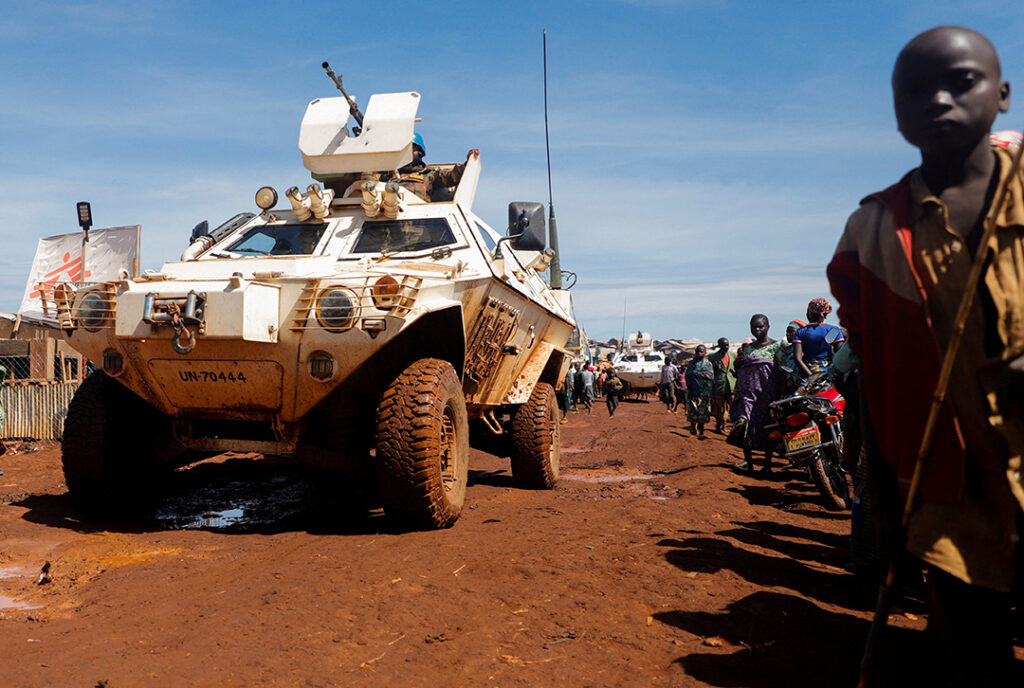ADF STAFF
The June massacre of 46 displaced persons in the Democratic Republic of the Congo’s Ituri-based Lala camp has fueled resentment residents feel toward the United Nation’s decadeslong peacekeeping mission there.
MONUSCO, the United Nations Organization Stabilization Mission in the Democratic Republic of the Congo, is the world’s largest peacekeeping mission. At $1 billion a year, it also is the most expensive peacekeeping mission.
First deployed in 1999, the mission included 20,000 members at its peak. Today, it has more than 12,500 troops.
Despite the mission’s size, duration and budget, experts and residents say it hasn’t brought peace to a region torn by interethnic conflicts and the quest to control the region’s trove of gold and other natural resources.
The fact that the massacre by CODECO, the Coopérative pour le développement du Congo, happened 5 kilometers from a MONUSCO base adds to public frustration with the U.N. mission.
The U.N. began the year with peacekeeping missions in the Central African Republic, the DRC, Mali, South Sudan, the disputed Abeyi region between South Sudan and Sudan, and Western Sahara.
The Mali mission began pulling out on July 1 after the ruling military junta expelled it. The DRC mission is due to close next year. All six missions have been criticized for failing to disrupt violent extremists or interethnic fighting. Supporters say peacekeepers are hampered by the proliferation of armed extremist groups, which employ guerrilla tactics that peacekeepers are not prepared to confront.
In response, Mali and other countries have turned to mercenaries such as the Russian Wagner Group. Wagner promises aggressive action against extremists, but it has not stopped violence in countries where it operates.
The attack by CODECO, a group composed of ethnic Lendu farmers, against members of the pastoralist Hema ethnic group reflects one of the root problems peacekeepers face in African nations, according to Ghanaian security analyst Fidel Amakye Owusu.
“It is the ethnic dimensions within states within Africa that creates some unrealistic expectation on the part of governments for U.N. peacekeeping missions on the continent,” Owusu told ADF.
Too often, governments led by members of one ethnic group expect U.N. peacekeepers to act on their behalf against their ethnic rivals.
“When the U.N. is not doing that, then the U.N. is seen as inefficient and inefficacious,” Owusu said.
U.N. peacekeepers can use lethal force only in self-defense or defense of their mandate.
Scapegoating the U.N. allows leaders to escape responsibility for their own inability to field security forces that are well-funded and reflect their country’s ethnic diversity, he added.
To make peacekeeping missions more effective, the U.N. needs to develop better connections with civilians where missions operate. MONUSCO is an example of a mission that would benefit from such a change, according to George Okach.
“There is no local ownership of the mission. To date, some Congolese view MONUSCO as a foreign entity that has no interest of the locals at heart,” Okach wrote for DW.com.
As a U.N. peacekeeping alternative, the African Union has launched its own peacekeeping efforts built around regional blocs such as the East African Community, which has intervened in the eastern DRC. The AU has called on the U.N. to fund such missions.
“It’s the most appropriate alternative,” Owusu told ADF.
Although those efforts put an African face on peacekeeping, they also can face credibility issues, particularly when dealing with ethnic disputes in which ethnic groups cross international borders, Owusu added.
“These are things that need a lot of careful planning,” Owusu said.
Along with African troops, AU-based peacekeepers would be wise to employ respected elder leaders to defuse tensions, he added.
“These are some of the things we need to look at if we’re going African,” Owusu said. “In Africa, the use of the elderly in resolving conflicts works.”

